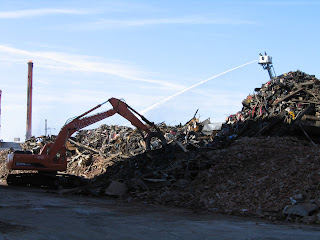Here we are again another summertime and another year of complaining about how bad
asbestos project monitors are. It seems this has become a summertime tradition. Project monitors who don't show up, don't do what they are told, don't know the regulations, sleep on the job, leave the job, don't know how many samples to take, etc., etc. We find this interesting because the project monitor should be one of the most knowledgeable people on an asbestos project. Not only should the asbestos project monitor understand air sampling requirements & theory, they should be able to read and understand building plans, be able to communicate effectively to get the
contractor to follow the specifications, regulations, and drawings, write legibly & diligently so the log can be read by others & they can know what happened on the project, be ready to testify in a court of law regarding what they observed on the project, handle scheduling, phasing, & timing on a project and handle a number of other issues related to asbestos abatement including
occupational safety and health issues.
When we have these discussions in our classes, our belief is that a project monitor should have a college education. In our opinion, high school students should never be hired for project monitoring (can we say interns, which is a person who should be in training (directly supervised) for the position they are interning for). As
Albert Einstein said:
"The value of a college education is not the learning of many facts but the training of the mind to think."
 |
| English: Albert Einstein Français : portrait d'Albert Einstein (Photo credit: Wikipedia) |
We see the problem as that asbestos project monitors are not respected for what they should be doing. This disrespect is primarily coming from certain building owners who feel there is no need for an asbestos project monitor who coordinates the project and
legally documents the project. The hourly rate for an asbestos project monitor should have been increasing over the years, however, this is not the case. Then you have building owners and abatement contractors who feel project monitors delay projects, well a good project monitor would actually reduce the amount of time a project takes. We agree with some that asbestos project monitors should be individually held responsible and liable for the work they do or don't do. This would definitely increase the quality of work and would make sure project monitors had some gumption! However, are project monitoring firms ready for a project monitor who actually dictates the job like project monitors in the past used to?
We have recently reviewed a number of project monitor logs and in the logs we reviewed project monitors made no entries other than the time they arrived, time for lunch, and the time they left for an
8-hour day. In our view
New York State Industrial Code Rule 56 created a minimum standard for a project monitor log by creating requirements for a supervisor log. Since the project monitor's log is supposed to document the project legally, the supervisor requirements are the minimum requirements, along with any additional information and events that occurred at the site/project that are legally important for the building
owner. In addition, if the project monitor didn't write it, it didn't happen. What does that mean? Well if the project monitor didn't make an entry in their log about aggressive sampling such as the amount of time for leaf blowing or the number of fans installed, etc. Well guess what, the project monitor didn't do it. The log is supposed to be a legal journal of what was done on the project. If the project monitor doesn't make an entry, well it probably wasn't done. Why would anyone assume otherwise?

In our view this is what has been forgotten regarding the importance of the asbestos project monitoring. We've heard of a number of issues with contractors and workers where they do not properly protect the workers from exposure or workers are not decontaminating properly. As a building owner this is important information that should be documented by the asbestos project monitor cause if a worker or a family member were to develop mesothelioma then the log would protect the owner from a potential third party litigation. This is one of the most important reasons for hiring an asbestos project monitor, the documentation of contractor, worker, & visitor violations and the cause of their potential exposure or the reason they were probably not exposed.
Recent investigations of project monitoring companies like CES (though a recent court decision may vindicate CES) and JMD, both of NY, indicate that the
Federal government is recognizing a problem with asbestos project monitoring. Even
New York City Department of Environmental Protection (NYCDEP) has focused some of its inspections/violations on the project monitoring firms. Covering everything from logbooks, chain of custodies, air sampling stands, visual inspections, etc. We think its time for some individual responsibility and the regulatory agencies should start issuing violations to the individual asbestos project monitor (as NYCDEP has done with asbestos supervisors). This would definitely increase the professionalism of the asbestos project monitors and hence increase the quality of the work performed on asbestos projects.











